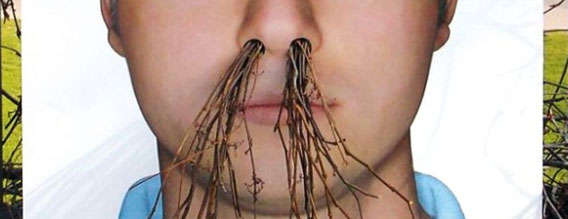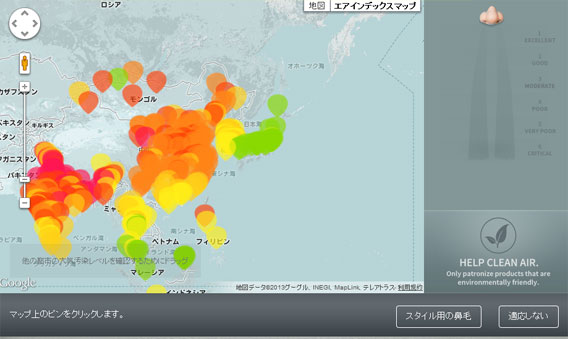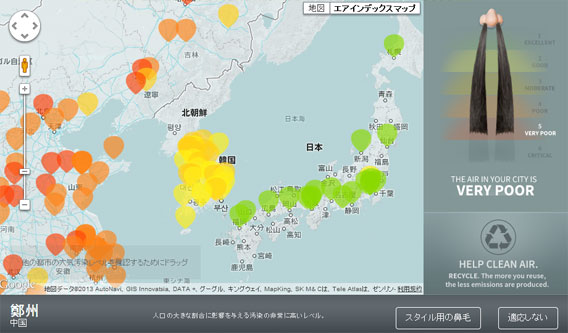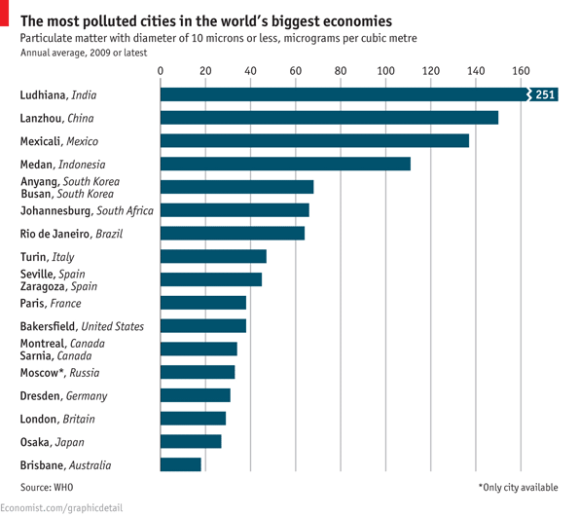
In recent years along with many other developing Asian nations, China has been increasing its level of industrial manufacturing as it readies itself for remarkable industrial growth. However, neglecting its environment for the sake of industry has brought with it the problem of dense smog pollution, with microscopic smog particles with a diameter of 2.5 micrometres or less having been detected in overwhelming large amounts in China’s air in recent days.
The smog is the same as that found in factory exhausts, car fumes and the like. Measured per cubic meter, at one instance the observed value of pollution in Beijing reached levels 10 times the Chinese government’s recommended safety level. If one were to go by the Wealth Health Organization (WHO)’s recommended value, the figure rises to 40 times greater than normal. When it comes to pollution, it is thought that of the asian nations undergoing remarkable growth, 70% of nations are reaching a critical level. The toxic substances that seep out into the environment cause asthma, pneumonia and even in some cases death.
Of course, those living in highly polluted areas will surely want to know how their air compares, but measuring the levels each time can prove tiresome and expensive. With this in mind, one innovative company called Clean Air Asia has stumbled upon a way determine just how polluted your air is, and has designed an interactive map based on – wait for it – nostil hair.
The method relies on the principle that the length of the nasal hair is directly related to the level of air pollution. Colour-coded and integrated into Google Maps, nostril hair length is made available to those concerned about the cleanliness of the air they breathe. By judging the average nostril hair length in any particular area, users can find out just how hazardous their environment is.
When you find an area on the map that you’re interested in, with a simple click, a nose icon appears on the right hand side of the screen. Depending on the level of pollution, the nasal hair length changes accordingly.
What do the different colors on the map mean?
If the colour is green, it means that you’re living in a clean area with no need for concern. Yellow means that the air around you is safe. When it comes to orange and red, the story is a little different: orange indicates the need for vigilance, while red, as I’m sure you have guessed by now, is the hazardous zone. I’m not quite sure just how fatal breathing in the air from the red zone would actually be, but it’s not something I’d like to try for experiment’s sake.
According to the World Health Organization (WHO), on a global scale, over 13 million people have died from air pollution-related illnesses; 8 Million of which being based in Asia.
Britain’s The Economist has made use of WHO’s findings on world air pollution by creating a worldwide “worst ten” polluted city ranking. Taking a peek below, India takes the lead, followed in second place by China, and then Mexico. To our readers out there, I urge to you to check out the graph below and let us know what you think about the idea that nostril hair length is related to air pollution. For those readers living in the worst 10, as bizarre a question as it is, do you feel that your nostril hair length has been affected? Feel free to leave a comment below.
Source: カラパイア
Inset images: カラパイア , The Economist



 Air quality in Beijing now so poor that sunrises are being broadcast on giant TV screens [UPDATED]
Air quality in Beijing now so poor that sunrises are being broadcast on giant TV screens [UPDATED] What’s the deal with these new nose gadgets Chinese policemen are wearing?
What’s the deal with these new nose gadgets Chinese policemen are wearing? Ramen restaurant’s English menu prices are nearly double its Japanese ones, denies discriminating
Ramen restaurant’s English menu prices are nearly double its Japanese ones, denies discriminating Here’s what our bachelor writers ate over the New Year’s holiday in Japan
Here’s what our bachelor writers ate over the New Year’s holiday in Japan Japanese beef bowl chain Sukiya’s 2026 Smile Box lucky bag basically pays for itself
Japanese beef bowl chain Sukiya’s 2026 Smile Box lucky bag basically pays for itself Things get heavy with the Gold Lucky Bag from Village Vanguard
Things get heavy with the Gold Lucky Bag from Village Vanguard New Japanese menstrual product seeks to help women spot unidentified iron deficiencies
New Japanese menstrual product seeks to help women spot unidentified iron deficiencies Nearly one in ten young adults living in Japan isn’t ethnically Japanese, statistics show
Nearly one in ten young adults living in Japan isn’t ethnically Japanese, statistics show Visiting the Kikyoya Shingen Mochi theme park takes some planning–but it’s a stop worth making!
Visiting the Kikyoya Shingen Mochi theme park takes some planning–but it’s a stop worth making! Japan has vending machines that put protective film on your phone for you — Here’s how to use them
Japan has vending machines that put protective film on your phone for you — Here’s how to use them Dragon Quest Slime toys appear at McDonald’s Japan in crossover with Grimace and pals【Video】
Dragon Quest Slime toys appear at McDonald’s Japan in crossover with Grimace and pals【Video】 Uniqlo releases T-shirt collaboration with K-pop group Treasure
Uniqlo releases T-shirt collaboration with K-pop group Treasure Starbucks Japan ready to get Year of the Horse started with adorable drinkware and plushies【Pics】
Starbucks Japan ready to get Year of the Horse started with adorable drinkware and plushies【Pics】 Hayao Miyazaki says Happy New Year to Studio Ghibli fans with new art for Year of the Horse
Hayao Miyazaki says Happy New Year to Studio Ghibli fans with new art for Year of the Horse Cup Noodle tries an authentic Jiro-style ramen, but something’s not quite right
Cup Noodle tries an authentic Jiro-style ramen, but something’s not quite right The best Starbucks Japan Frappuccinos we want to drink again in 2026
The best Starbucks Japan Frappuccinos we want to drink again in 2026 We revisited Sweets Paradise after a decade to see if Japan’s dessert buffet still delivers
We revisited Sweets Paradise after a decade to see if Japan’s dessert buffet still delivers That time Seiji called JASRAC to ask why he didn’t get paid royalties for his song being on TV
That time Seiji called JASRAC to ask why he didn’t get paid royalties for his song being on TV We found possibly the quietest Japanese-style hotel in Tokyo’s bustling Shinjuku district
We found possibly the quietest Japanese-style hotel in Tokyo’s bustling Shinjuku district Pizza Hut Japan’s hot lucky bags are perfect for a New Year’s pizza party
Pizza Hut Japan’s hot lucky bags are perfect for a New Year’s pizza party Japan’s oldest largetooth sawfish in captivity back on display in Mie Prefecture
Japan’s oldest largetooth sawfish in captivity back on display in Mie Prefecture 7-Eleven Japan starts new temporary luggage storage service in over 300 branches
7-Eleven Japan starts new temporary luggage storage service in over 300 branches Disillusionment at Tsukiji’s tourist-target prices led us to a great ramen restaurant in Tokyo
Disillusionment at Tsukiji’s tourist-target prices led us to a great ramen restaurant in Tokyo Starbucks teams up with 166-year-old Kyoto doll maker for Year of the Horse decorations【Photos】
Starbucks teams up with 166-year-old Kyoto doll maker for Year of the Horse decorations【Photos】 Tokyo considering law requiring more trash cans following litter increase in heavily touristed area
Tokyo considering law requiring more trash cans following litter increase in heavily touristed area Tokyo’s Tsukiji sushi neighborhood asks tour groups to stay away for the rest of the month
Tokyo’s Tsukiji sushi neighborhood asks tour groups to stay away for the rest of the month Tokyo event lets you travel back in time, for free, to celebrate 100 years since Showa era start
Tokyo event lets you travel back in time, for free, to celebrate 100 years since Showa era start Japan may add Japanese language proficiency, lifestyle classes to permanent foreign resident requirements
Japan may add Japanese language proficiency, lifestyle classes to permanent foreign resident requirements Sanrio theme park in Japan announces plans to expand into a Sanrio resort
Sanrio theme park in Japan announces plans to expand into a Sanrio resort Stamina-destroying “Paralysis Noodles” are Tokyo’s newest over-the-top ramen innovation
Stamina-destroying “Paralysis Noodles” are Tokyo’s newest over-the-top ramen innovation Survey asks foreign tourists what bothered them in Japan, more than half gave same answer
Survey asks foreign tourists what bothered them in Japan, more than half gave same answer Japan’s human washing machines will go on sale to general public, demos to be held in Tokyo
Japan’s human washing machines will go on sale to general public, demos to be held in Tokyo Japan’s deadliest food claims more victims, but why do people keep eating it for New Year’s?
Japan’s deadliest food claims more victims, but why do people keep eating it for New Year’s? We deeply regret going into this tunnel on our walk in the mountains of Japan
We deeply regret going into this tunnel on our walk in the mountains of Japan Studio Ghibli releases Kodama forest spirits from Princess Mononoke to light up your home
Studio Ghibli releases Kodama forest spirits from Princess Mononoke to light up your home Major Japanese hotel chain says reservations via overseas booking sites may not be valid
Major Japanese hotel chain says reservations via overseas booking sites may not be valid Put sesame oil in your coffee? Japanese maker says it’s the best way to start your day【Taste test】
Put sesame oil in your coffee? Japanese maker says it’s the best way to start your day【Taste test】 No more using real katana for tourism activities, Japan’s National Police Agency says
No more using real katana for tourism activities, Japan’s National Police Agency says Starbucks Japan reveals new sakura drinkware collection, inspired by evening cherry blossoms
Starbucks Japan reveals new sakura drinkware collection, inspired by evening cherry blossoms Updated cherry blossom forecast shows extra-long sakura season for Japan this year
Updated cherry blossom forecast shows extra-long sakura season for Japan this year
Leave a Reply